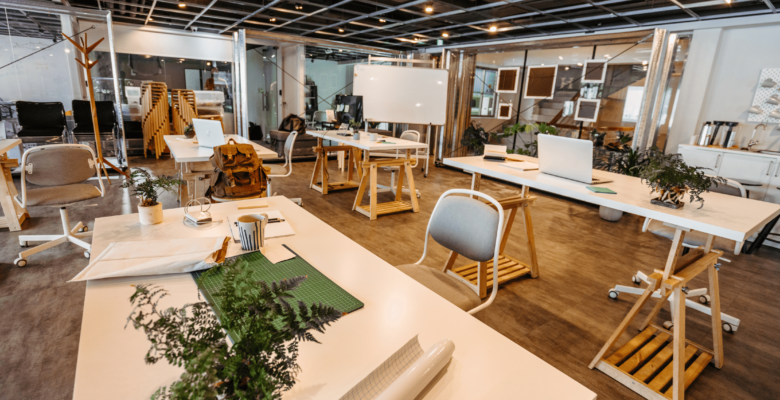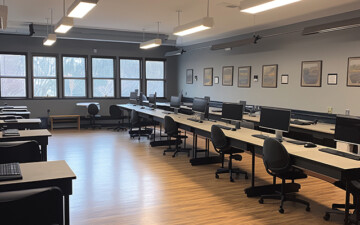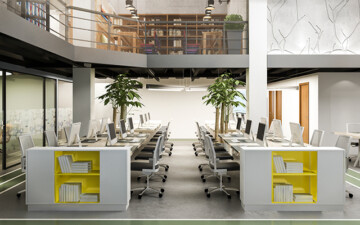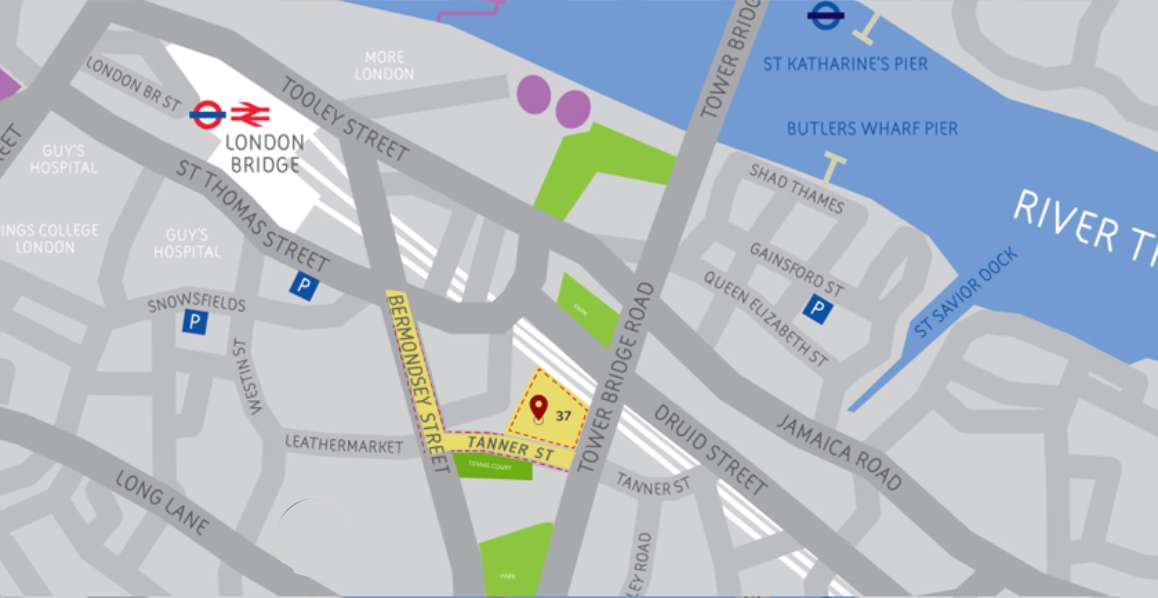The nature of work has changed dramatically in recent years. Employees now demand flexibility in when, where, and how they do their jobs. This evolution has led companies to reimagine the traditional office blueprint in favour of a modern workspace design.
What defines these contemporary environments? They cater directly to the elements that make today’s workforce more productive. Open floor plans allow for easy collaboration, while small huddle rooms enable focus. Integrated technology provides seamless virtual connectivity. Ultimately, these spaces are flexible and adaptive to support workers across roles, and projects.
In fact, a study by Savills found that 65% of employees believe that if their office matched their ideal layout, their productivity would improve. Indeed, modern workflows fueled by smart workplace design lead to innovation, efficiency, and results.
This guide will explore what defines a modern office space and how you can optimise your own workspace to help employees thrive.
Consiously Designed Private Office Space
benefits of booking private office is based on your needs
What is a Modern Office Space?
A modern office space is designed to support the needs of a contemporary workforce by providing them with an agile work environment. The foundation of the modern office centers around openness and communication. This progressive workspace creates a culture that grows and adjusts according to a company’s and employees needs.
Instead of closed-off rooms, the priority while designing a modern office space is variety and mobility. With minimal yet efficient layouts that enable productive team interactions, this new work ecosystem provides the ideal space for people to connect and share their ideas. Here is a further breakdown of what makes for a modern office:
What are the Key Components of Modern Office spaces?
The following components complete a modern workspace:
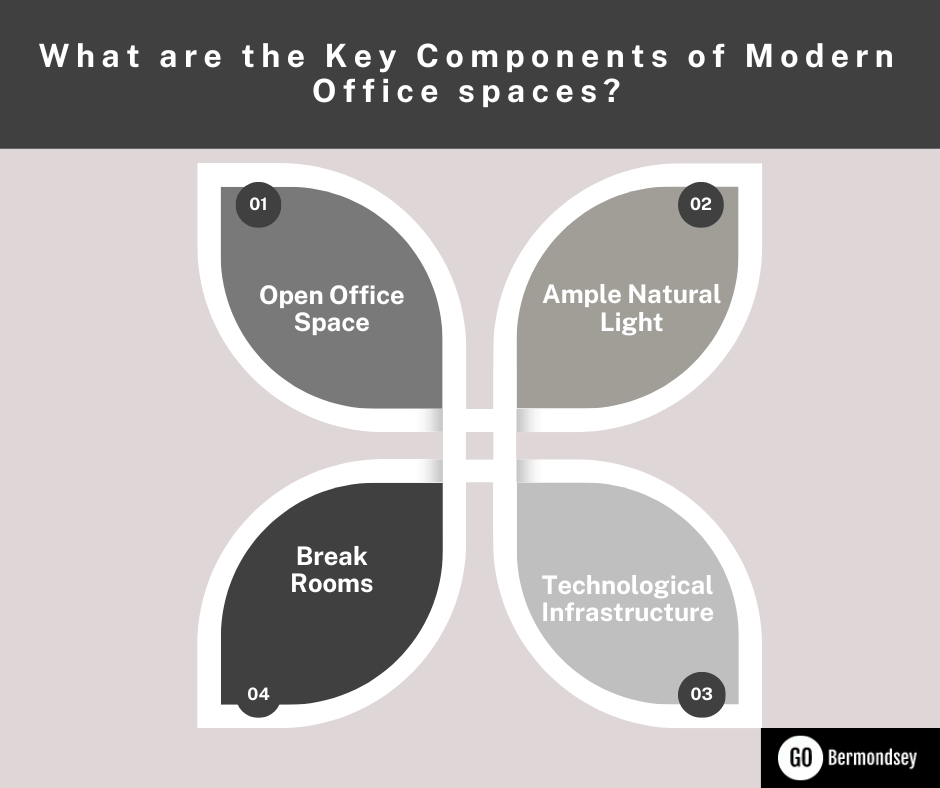
- Open Office Space: Modern offices often incorporate open-floor plans, there are fewer walls dividing up spaces. Instead of private closed-off offices, walls are lowered, and desks are arranged in a large open area. This layout leads to improved visibility across the office, facilitating freer communication.
- Ample Natural Light: A hallmark of modern office design is the incorporation of abundant natural light through elements like windows, skylights, and glass partitions.
- Technological Infrastructure: Given our reliance on technology today, modern offices prioritise integrating high-speed WiFi, ample charging stations, AV conferencing screens, and other modern tech facilities to enhance employee productivity.
- Break Rooms: Recognising the importance of employee well-being, modern workplaces include break rooms. These spaces provide employees with the opportunity to take breaks from their standard work routines, fostering a healthier work environment.
Also read, How to plan an office space?
What are the Advantages of a Modern Office?
The strategic design of a modern workplace has many benefits:
- Boosts Productivity: A modern office environment spurs productivity by providing employees with a comfortable and practical place to work. Fluid floor plans and designated meeting spaces enable the free flow of ideas between employees.
- Attracts and Retains Top Talent: Modern, progressive office spaces signal a forward-thinking culture that appeals to both current employees and job-seekers. A sophisticated, tech-integrated workplace makes talent acquisition and retention more seamless.
- Promotes Sustainability: The modern office space is designed to be sustainable. For instance, it integrates abundant natural daylight, reducing electricity consumption and related expenses.
- Derives Adaptability: Strategic workplaces facilitate adaptation through flexible furniture, movable partitions, and technology integrations. Companies can promptly respond to changing business needs, foster innovation, and support growth. The result is an office equipped for whatever the future brings.
What is the Difference Between a Traditional Office and a Modern Office?
The table below highlights the differences between modern and traditional offices.
| Characteristic |
Modern Offices |
Traditional Offices |
| Interior |
Features light décor, large spaces, minimal furniture. |
Dated décor, possibly private cubicles. |
| Management Costs |
These office spaces take care of everything, from printing facilities to a running kitchen and service personnel, thereby reducing management costs. |
Owners have to manage every aspect of running an office, leading to increased management costs and efforts. |
| Furniture and Amenities |
Minimalistic yet ergonomic furniture and green plants. |
Lacks innovative furniture and amenities. |
| Flexibility |
Leans towards a hybrid approach, allowing the office space to be scaled up or down when needed. |
Fixed office space leads to difficulties in scaling the business up or down. |
| Lease Commitments |
Office space can be leased for short-term or whenever required. |
Leases are often long-term. |
What to Strive for When Creating a Modern Office Space?
While you thoughtfully design a modern office space, make sure that the elements you incorporate align with your company’s unique vision and values. Below are some points to consider while creating a modern office space:

- Stimulating Creativity, Collaboration and Communication: Collectively called the three C’s, these three qualities contribute to creating a productive office space. In the context of modern office spaces, the design should spark creative thinking through elements like artwork, colour patterns, and unique spatial layouts. Additionally, dedicated meeting areas and digital tools should be incorporated to facilitate seamless collaboration and communication.
- Reducing Stress and Anxiety: The main feature of a modern office space is that it values the mental state of its employees. Instead of loud furnishings and dated décor, the contemporary workspace must include a softer and more neutral aesthetic. Consider incorporating a Biophilic office design that can harness the revitalising qualities of nature. Well-designed office spaces have been known to reduce stress levels by 21%.
- Enable Focused Work: While collaboration is the key to a company’s success, your employees need some space to complete their individual tasks on time. Therefore, a modern workspace must ensure that there is space for both collaboration and independent, focused work.
- Portray a Professional Image for Clients: The right office design can showcase innovation, success and a strong infrastructure to visiting clients and partners. A professional, modern workspace can help make the right first impression, building confidence in the capabilities of the company while also reflecting the brand’s values. Therefore, you must aim to create a space that conveys a commitment to growth and staying professional, to build a strong image before the clients.
- Seamless Integration for Collaboration: Since the modern workplace is designed to unite in-person and virtual teams, you must ensure smooth technology integration. By making use of technology, for example, video conferencing tools, you can establish continuity between in-office and remote teams. Modern workspaces must be designed to dissolve barriers between onsite and offsite staff. It should ensure that all the employees remain equally aligned, productive and included.
Modern Workspace Design Trends
Modern office spaces incorporate areas that may be utilised according to the changing requirements of the employees. Here are some design trends in these workspaces:
- Big and small meeting rooms are a popular element in modern offices. They are tech hubs that facilitate quick collaborations among colleagues.
- Movable glass walls and flexible furnishings are also a part of many modern office spaces enabling adaptable seating arrangements.
- The modern workspace design also features creative spaces. These are open spaces with whiteboards or glass walls to write on, have flexible seating arrangements and technology to facilitate communication.
- Companies are also focusing on customised boardrooms and client meeting areas that integrate brand aesthetics.
- Besides the professional spaces, break rooms and kitchens are also becoming integral to the modern office.
Also read, How much does it cost to rent an office space in London?
How Does Your Working Style Impact the Amount of Office Space You Need?
The amount of office space a company needs depends on the working styles of its employees. Companies with primarily collaborative teams who spend much of their time in meetings, brainstorming sessions, and group work require more open, communal spaces like conference rooms and huddle areas. These collaborative layouts allow for frequent inter-team interactions.
On the other hand, companies that mainly focus on individual work need more segmented spaces for concentrated work, like private offices. Ideally, your office layout should accommodate different settings for different tasks, providing both collaboration zones and quiet areas for focused work.
How Do You Modernise Your Office Space?
The modern workplace represents a shift in work culture driven by the demand for flexibility. With 83% of employees preferring a hybrid work model as their preferred work arrangement, office layouts must align with this new reality.
Thus, when designing a modern office space, start by gaining a deep understanding of your employees’ needs. Observe how your teams currently collaborate in-person. What types of spaces encourage creativity, how large should your collaborative space be, how much space should be allocated for focused work? Engage employees directly to learn what workplace elements they find most productive.
Use these insights to build a consciously designed environment that matches real-world routines. Seek to provide a balance of open, collaborative areas for group sessions with quieter pods for heads-down work. The goal is to create a professional yet inviting workplace truly tailored to how your employees operate at their best.
Why Choose Garden Office Bermondsey as Your Modern Office Space?
Garden Office Bermondsey provides contemporary private offices and meeting rooms for rent in London, specially made to empower today’s workforce. We offer a range of sleek, professionally designed modern office spaces. From customisable private offices to state-of-the-art meeting rooms equipped with the latest AV technology, our sustainable workspace has everything you need. Our modern amenities and features align perfectly with current workplace design trends and foster productivity. By selecting Garden Office Bermondsey for your company, you provide your team with a motivational, future-ready environment tailored to their working style. To book a modern office space, visit Garden Office Bermondsey today!
